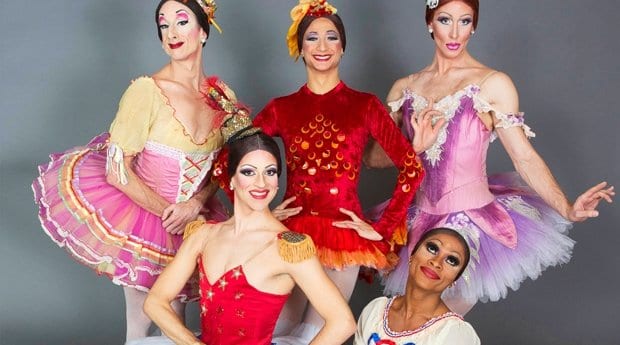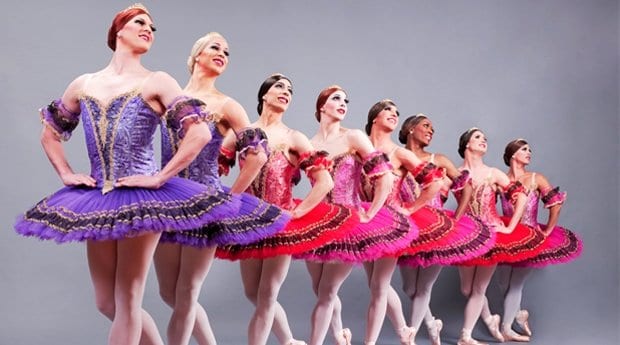
Credit: Les Ballets Trockadero
With their tutus, delicate pointe shoes and copious tufts of chest hair, the ballerinas of Les Ballets Trockadero de Monte Carlo have been charming audiences around the world for 40 years.
On Jan 24, the Trockadero troupe — lovingly known as the Trocks by their legions of fans — will be in Vancouver for a one-night-only performance at the Queen Elizabeth Theatre. It is the first time since 1985 that the internationally renowned all-male drag ballet company has visited the city.
Parodying classic ballets, the professionally trained dancers combine technical skills with a wicked sense of humour to engage the audience and affectionately critique the structure of gender stereotypes in conservative dance. It’s ballet, with a twist.
“What we do is take these Russian choreo-graphies and we do them as males en pointe for comedy,” explains Tory Dobrin, the artistic director of Les Ballets Trockadero. “People walk away with the sense that it’s a fun show and it’s good dancing.”
The company traces its roots back to the early gay liberation movement and the Stonewall riots in New York in 1969. The Trockadero emerged five years after Stonewall, at a time when drag was prominent in downtown NYC clubs and in off-off-Broadway performances. Coincidentally, North American culture was also witnessing an explosion in the popularity of ballet. Mikhail Baryshnikov had just defected from the Soviet Union and dance was in the forefront of theatre.
According to Dobrin, the Trocks were playing around with dance conventions at the time to achieve their mission, which has remained unchanged since its inception four decades ago. Using drag as a tool to specifically represent ballerinas rather than women more generally, the Trocks set out to expose the traditional roles and eccentricities of classical ballet from a different perspective.
It’s about dancing the fine line between high art and high camp, Dobrin says, not to mention sharing their enthusiasm for dance with the widest possible audience. At the end of the day, that’s “the most important element of it,” Dobrin says.
Raffaele Morra has been dancing with the Trocks since 2001. Crossdressing in traditional ballet is mainly used for two purposes, he explains: a girl dressed as a man is used to portray a child, and a man dressed as a woman is meant to enhance the comedic aspect — like Cinderella’s ugly stepsister — or make a character appear more evil or grotesque.
“With the Trocks, each dancer has the opportunity to break those limitations as we portray a pretty princess or delicate swan or an ethereal sylph,” Morra says.
Morra has been dancing professionally for 20 years in both Italy and the United States. When he joined the Trocks 14 years ago, he was looking to get away from what he considers the darker elements of traditional ballet that make it difficult for audiences to enjoy or understand a show.
“I wanted to do something lighter and something more entertaining,” he says. “I saw a performance of the Trocks and knew that this was it. This was classical ballet that I always loved, a lot of comedy and a lot of interaction between the dancers and the audience.”
Morra was more than happy to portray both female and male roles, as he believes that art has no gender. While onstage, he dances as Pepe Dufka or Lariska Dumbchenko. Although the names and biographies are assigned, he says that after so many years the dancers and their characters begin to blend together.
“I recognize myself in Lariska Dumbchenko,” he says. “It’s not only the makeup; you also really feel that you’re becoming someone else. You become the ballerina that is onstage.”
Merging professional dancing, comedy and a healthy exchange between the performers and the audience, Morra says the Trocks’ spin on old ballet makes it interesting for modern spectators. “They can actually enjoy ballet, laugh at ballet with us,” he says.
Show One Productions is the company responsible for bringing Les Ballets Trockadero to Vancouver. President Svetlana Dvoretsky stresses that although the show does parody classical ballet, it’s not a group of people fooling around onstage.
The Trocks are the “utmost professionals,” she says, attributing their success to their accessibility to all levels of audiences. “Ballet connoisseurs and dance connoisseurs, they will find what they like there, and for people who just happen to be in the audience for the first time, they will enjoy it equally as much,” she says. “No one will leave disappointed.”
The two-hour Vancouver show will feature several ballets, including Swan Lake, Act 2, one of the troupe’s signature works, and three shorter performances, including Go for Barocco, The Dying Swan and Paquita.
Les Ballets Trockadero de Monte Carlo
Sat, Jan 24, 8pm
Queen Elizabeth Theatre
649 Cambie St
$29–105 at ticketstonight.ca
showoneproductions.ca

 Why you can trust Xtra
Why you can trust Xtra


